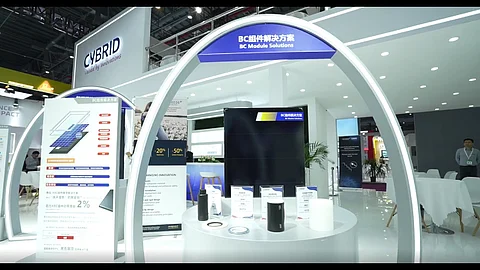

Cybrid promoted its EVA, POE, and EPE-based solutions for encapsulating different BC module configurations at the show
The company displayed its insulating ribbons, which offer protection for the BC module’s positive and negative rear side metal ribbons
It also offers 3 backsheet variants with PET-core layers
Cybrid Technologies was one of a few PV material suppliers that showcased their latest offerings during SNEC 2025. The company, specializing in polymer-based PV encapsulant and backsheet solutions, promoted its portfolio targeted at back contact (BC) PV modules.
In the XBC Module Solutions subsection under Products on the company’s website, encapsulants are categorized as EPE (EVA-POE-EVA) and POE (Polyolefin). However, the insulating tape and backsheets are not differentiated further. All these products are offered in multiple variants, suited for diverse BC module configurations.
POE is an encapsulant based on polyolefin polymer resin, while the EPE is the combination of EVA (Ethylene-Vinyl Acetate) and polyolefin.
EPE (EVA-POE-EVA) & POE
Alongside EPE, Cybrid has clubbed EVA and PO-based variants under the same subsection. The Cybrid B11H black EVA, developed for a BC module’s rear-side encapsulation, features a black surface on the cell side and white on the back side. In addition to its aesthetic attribute, it reportedly offers good reflectivity from the inner layer. Suitable for single-glass and double-glass configurations, it exhibits requisite adhesion strength with the underlying glass and metal ribbons of the BC module. However, the company didn’t disclose the rated maximum adhesion values.
Cybrid W11H, featuring layers of white EVA and POE, is developed through a coextrusion process. The company claims this product has an unquantified good reflectance value. It has a transparent surface for the inner side (cell side), while the backsheet or glass side is white, indicating its applicability to the rear side of the BC module. The company stated that, during the lamination process, it can deliver a BC module laminate, avoiding defects like cell shifting or bubble formation. These can be attributed to the film’s characteristics, which converge the properties of EVA and POE. It also offers the required adhesion strength with glass and backsheet, while Cybrid has not specified the values.
Meanwhile, for the BC module’s front-side encapsulation, the company showcased its Cybrid T22H and Cybrid T22 series POE film. Both, fabricated in a coextrusion process, have a transparent surface; however, the rated transmittance values are unavailable. Its unspecified volume resistance contributes to its anti-PID property. Having identical characteristics to the former, the T22 variant features a UV cutoff functionality.
Contrary to the traditional n-type cell, BC cells require adjusting both positive and negative polarities on the rear side of BC cells. This results in a metallization layout where metal ribbons of opposite polarity are placed at close proximity, during the cell-to-cell interconnection process. During the lamination process, the misalignment of these ribbons might cause a short-circuit. Addressing these challenges, the company is offering its Cynagard 115G (black) and Cynagard 115G (white) protective tape. These tapes have a cross-sectional structure – EVA + Fluorine film + PI film + Fluorine film - from the cell side to airside. The EVA film provides cushioning and protection against environmental stresses. Both tapes are compatible with a 1,000 V and 1,500 V DC system voltage BC module.
In the backsheet category, the company lists 3 PET-based products – Cynagard 295D, Cynagard 275A, and Cynagard 275A (fluorine-free).
The Cynagard 295D has a double-layer structure of a thin fluorine skin (cell-side) and an ‘Enhanced PET’ layer (air side). Available in black inner and white outer color, it can be used for a 1,500 V DC system voltage-rated distributed generation (DG) application monofacial BC module.
In contrast, the Cynagard 275A series has a multilayer structure. It includes additional layers of a PET film, a barrier coating, and an adhesive layer between the cell side fluorine skin and an airside ‘Enhanced PET film’. This structure results in the water vapor transmission rate (WVTR) of less than 0.5 g/m²/day, claimed Cybrid. It can be used for a 1,500 V monofacial BC PV module. In addition, the company can provide a fluorine-free variant of this backsheet.
